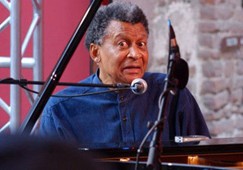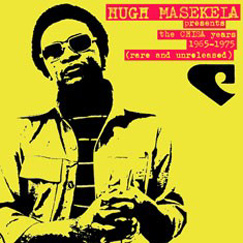Arts and culture
South African music: jazz in exile
- Previous page: The new jazz
Abdullah Ibrahim
Ibrahim is undoubtedly the towering figure in South African music, a man who brought together all its traditions with a deeply felt understanding of American jazz, from the orchestral richness of Duke Ellington's compositions for big band to the ground-breaking innovations of Ornette Coleman and the 1960s avant-garde. Ibrahim took the essential American music, jazz, the product of the descendents of slaves forcibly removed from Africa to the Americas, gave it a new shot of African life, and re-exported it to the Americans and the wider world. On his first trip overseas, to Switzerland in 1962, the pianist-composer met and impressed Duke Ellington himself, who sponsored his first recordings. Later, in New York, Ibrahim absorbed the influence of the early 1960s avant-garde, which was then pioneering new open-ended forms of spontaneous composition. Over the next four decades, Ibrahim developed his own distinctive style, slipping back into South Africa in the mid-1970s to make a series of seminal recordings with the cream of Cape jazz players - such as Basil Coetzee and Robbie Jansen. These included his masterpiece, "Manenberg", one of the greatest South African compositions ever, which became the unofficial soundtrack to the anti-apartheid resistance. Ibrahim's extensive oeuvre has continued to expand the South African musical palette, as he has worked as a solo performer (in mesmerising unbroken concerts that echo the unstoppable impetus of the old marabi performers), with trios and quartets, with larger orchestral units and, since his triumphant return to South Africa in the early 1990s, with symphony orchestras. He has also founded a school for South African musicians in Cape Town.Hugh Masekela
Ibrahim's old collaborator, the trumpeter Hugh Masekela, also had a glittering career outside South Africa. Initially inspired in his musical growth by Trevor Huddleston - a British priest working in the townships who financed Masekela's first trumpet - Masekela played his way through the vibrant Sophiatown scene and to Britain with "King Kong", to find himself in New York in the early 1960s. Masekela had hits in the United States with the poppy jazz tunes "Up, Up and Away" and "Grazin' in the Grass". A renewed interest in his African roots led him to collaborate with West and Central African musicians, and finally to reconnect with South African players when he set up a mobile studio in Botswana, just over the South African border, in the 1980s. Here, Masekela re-absorbed and re-used mbaqanga modes, a style he has continued to use since his return to South Africa in the early 1990s.The Blue Notes
Also pursuing the expansion of South African jazz into new realms, though in Britain, was the band The Blue Notes. Having made a name for themselves in South Africa in the early 1960s, this dymanic, adventurous group, led by pianist Chris MacGregor, left for Britain in the late 1960s and stayed there. The other members of the band - Dudu Pukwana, Mongezi Feza, Johnny Dyani and Louis Moholo - contributed richly to the sound of this ever-evolving ensemble, and also recorded significant solo material. The Blue Notes, and later MacGregor bands such as Brotherhood of Breath, as well as the Pukwana and Moholo bands, became an essential part of the European jazz avant-garde, carrying the African influence far beyond South Africa's shores. Sadly, all of the former Blue Notes, except Louis Moholo, died in exile.The story continued ...
Would you like to use this article in your publication or on your website? See: Using SAinfo material

World renowned South African pianist and composer Abdullah Ibrahim (Photo: Adbullah Ibrahim)

Hugh Masekela presents the CHISA years, 1965 - 1975 (rare and unreleased). Masekela enjoyed a glittering career over three decades in exile, before returning to South Africa in the early 1990s


